Special thanks to the kind folks at
This Week in Retro.
They featured this article in their
episode on August 17, 2024
(at minute 48:40).
Time Bandit
A Love Letter to the Game That Sold the Atari ST
When the Atari ST was introduced, it had a stand-out game: Time Bandit by Bill Dunlevy and Harry Lafnear. It was a wonderful action-arcade game with kick-class graphics, puzzles and text adventure elements. In this slice of retro gaming and computer history we dive deep into the colorful time gates, two player action and strange new arcade worlds!
August 2024
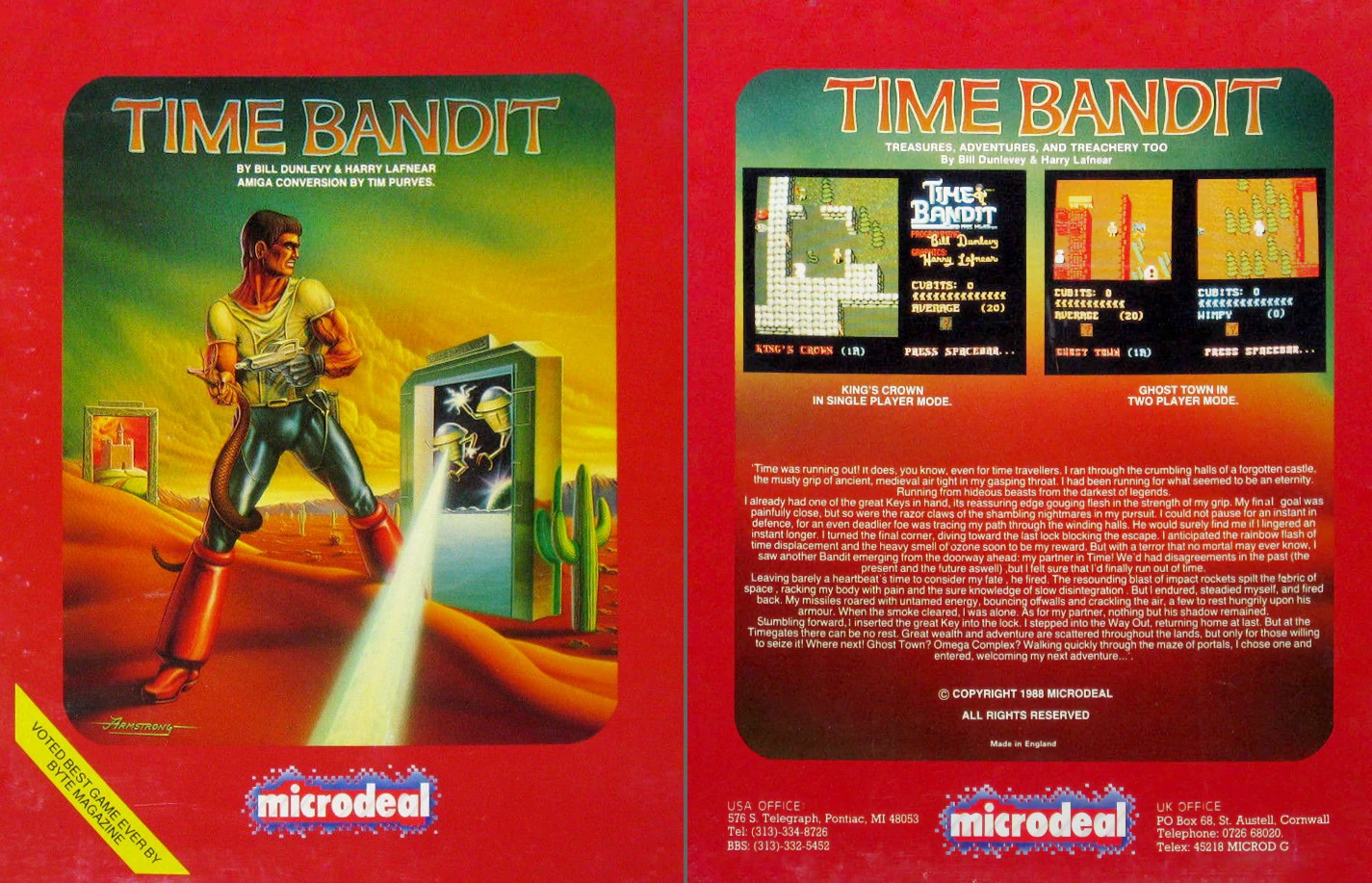
In 1985 Atari released their first 16-bit computer called the 520ST. It was equipped with 512 Kbytes of RAM, a Motorola 68000 CPU clocked at 8 MHz and with its 512 colors it had graphics that were superior to any machine at the time. At least until Commodore released the Amiga 1000 a few months later. Like the very first Apple Macintosh, released a year, prior, the Atari ST was mouse operated and had a graphical user interface, a novelty at the time.
At first there were very few applications and games. The paint program NeoChrome had been developed in-house at Atari and was released as freeware against its developer's wishes. It was not yet ready. It was a really nifty application with comparatively few but very polished functions. It had a real-time magnifying glass that was available at all times when the toolset was open. There were also some early arcade conversions by Atari, e.g. the delightful Joust and the 8-bit Atari's own classic Star Raiders, albeit with much upgraded graphics. There were some other games and applications but no "system seller" yet. That would turn out to be the wonderful role-playing game Dungeon Master in 1987. (And of course the numerous DTP and MIDI music applications much later in the ST's life.)
But which game would sell the Atari ST right after it was released?
Enter Time Bandit by Bill Dunlevy and Harry Lafnear, released by Microdeal/Michtron. It was one of the earliest third-party games released for the ST, a classic action-adventure game.
Click on images to zoom in.
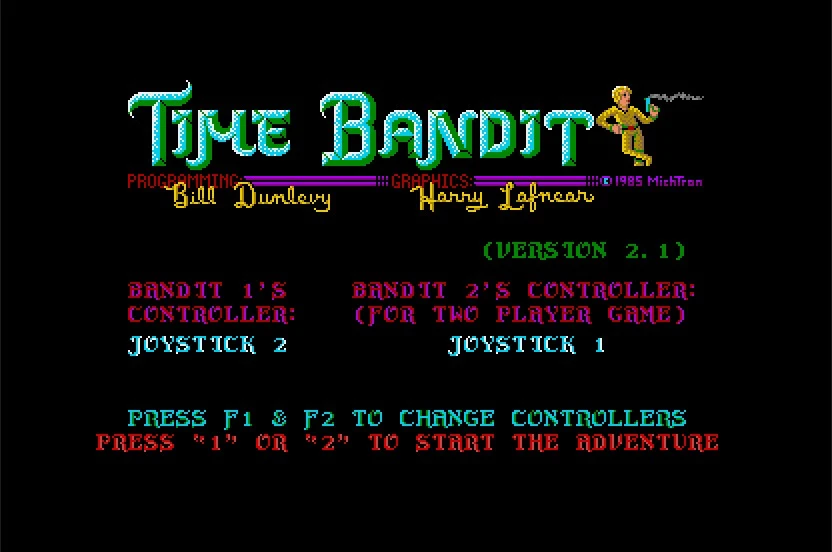
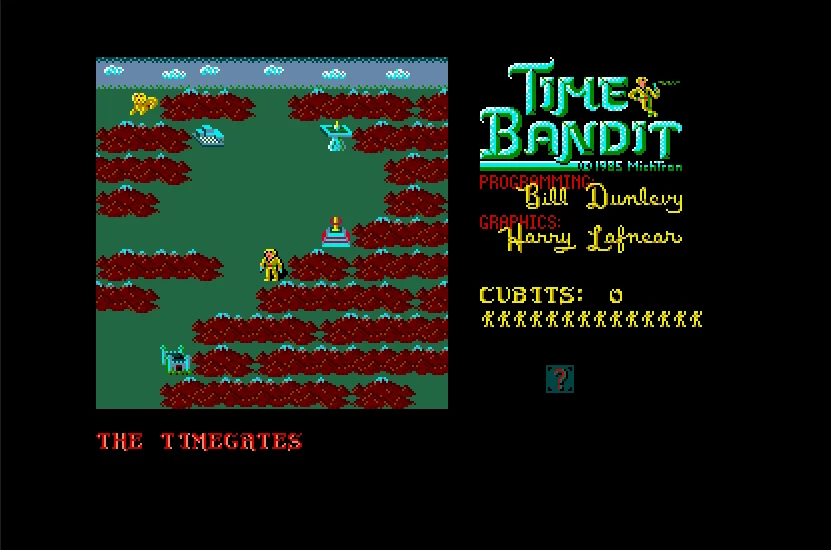
What Makes Time Bandit Special
Time Bandit is a blend of arcade shooter and puzzle elements that showcased the Atari ST's capabilities with vibrantly colorful graphics and comparatively smooth scrolling (something that the ST's hardware did not support out of the box). The game takes players on a whirlwind journey through various time periods and fantastical worlds, each filled with unique challenges and intriguing puzzles as you guide your daring hero through myriad mazes, battling enemies and collecting treasures.
You play the game from a top-down view traveling through time gates to one of a number of different worlds, each has unique enemies, traps, and even distinct gameplay. Players defend themselves by shooting their surprisingly large bullets. The objective is to collect treasure and find the keys to get back out of the world. The more often you access a world, the harder it gets. There are even some sections with short text adventures.
The brilliance of Time Bandit lies in its ingenious combination of arcade-style shooting and strategic problem-solving, making every moment a delightful surprise. Whether the player is exploring the mysterious corridors of ancient civilizations or navigating the futuristic hallways of a spaceship, the thrill of discovery and the joy of overcoming obstacles make Time Bandit a truly unforgettable adventure. With its richly detailed environments and engaging storyline, Time Bandit is a must-play for anyone seeking a game that perfectly balances excitement, creativity, and sheer fun!
The first time I played Time Bandit was in 1986 on my family's Atari 520ST+. This was the year, we had upgraded from the 8-bit Sinclair ZX Spectrum.
My mind was blown! On a superficial level, Time Bandit was a top down all-directionally scrolling shooter. But it was so much more. The game featured a wide range of worlds, each with its own unique theme and set of challenges. This variety always kept the gameplay fresh and engaging. Time Bandit combined elements of puzzle-solving with fast-paced action. This blend requires players to think strategically while also reacting quickly to enemies and obstacles.
I loved the non-linear gameplay. The game allows players to choose their own path through the different worlds, providing a sense of freedom and encouraging exploration of the many different scenarios. This also means that it was supremely replayable. The multiple worlds and varying paths mean that I experience something new each time they play, making the game highly replayable.
The levels were just so well-designed with intricate layouts and clever traps, offering a challenging and rewarding experience. The monsters and opponents were varied. Some shoot at you, others explode when hit potentially hurting the player with the shrapnels from the blast.
I loved the game. It just has such a creative approach to blending different gaming elements and providing a rich, immersive experience. When I returned to Time Bandit for this article, it brought back fond memories with its distinctive graphics and sound.
Gameplay
Time Bandit bears a resemblance to the Atari/Tengen arcade classic Gauntlet but definitely predates it. Like Gauntlet it is a top-down maze game that combines elements of action, adventure, and puzzle-solving. The player controls the titular Time Bandit, who travels through time and space to various worlds to collect treasures and defeat enemies.
Gameplay Video of Time Bandit
Watch on Wasibim's Youtube Channel
The Many Worlds of Time Bandit
As the name suggests, the player can access multiple time zones and settings ranging from ancient Egypt, the Wild West to futuristic sci-fi settings. Each world looks different and has different monsters.
Each world typically contains multiple levels, and the player must navigate through these levels by solving puzzles, collecting treasures, and defeating enemies. The game's structure encourages exploration and replayability, as players can travel between worlds and revisit levels to discover secrets and unlock new paths. Players must collect keys that unlock the portals leading out of the various worlds.
The player starts out in the time gates level and uses these portals to travel between different worlds and time periods. Each time the player accesses a world, and completes it successfully, the level of this world increments. The next time the player goes to the same world, it becomes slightly harder to complete.
If the player lingers too long in the time gate level, then a UFO appears. It hovers around the player. If it touches the player, then they are transported to a world at random!
Traveling the Multiverse
These are the worlds and levels featured in the game.
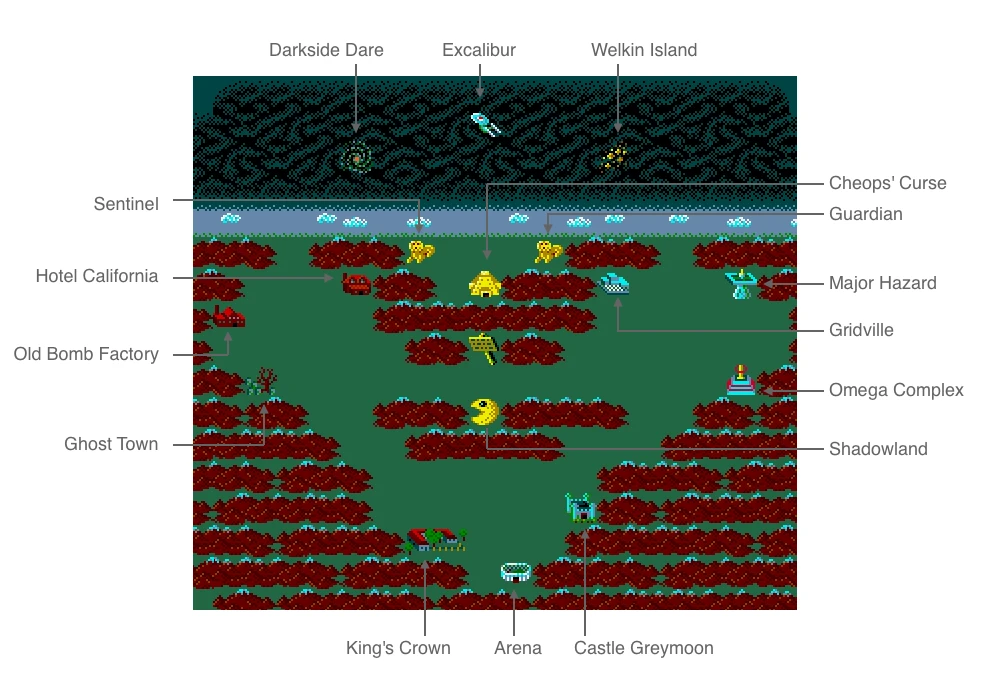
Deep Space Worlds
Click on images to zoom in.
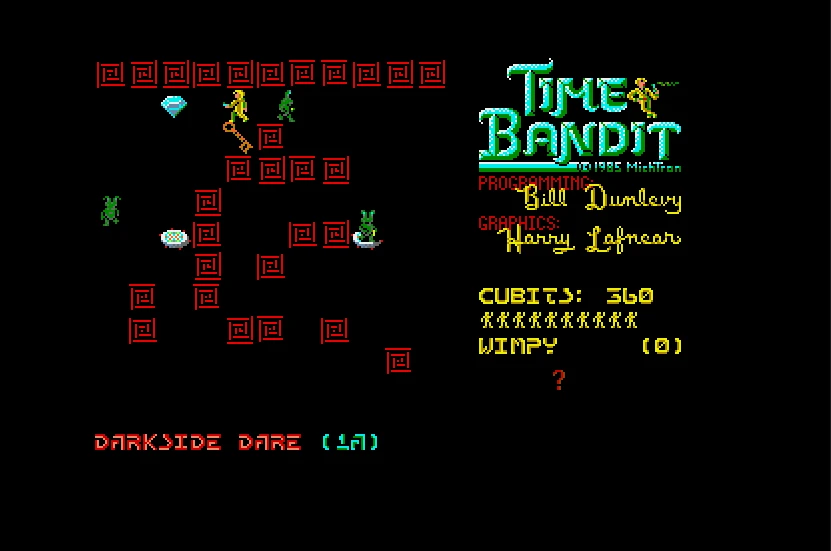
Darkside Dare
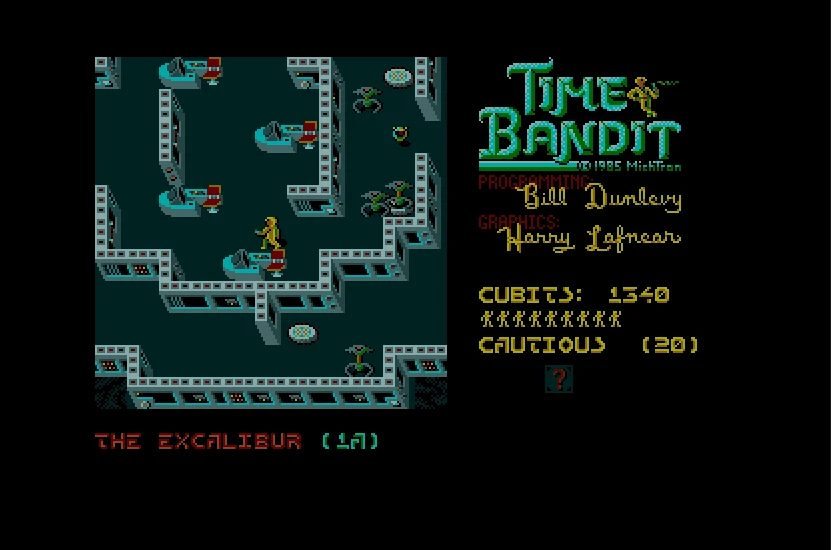
The Excalibur (a Star Trek adventure)
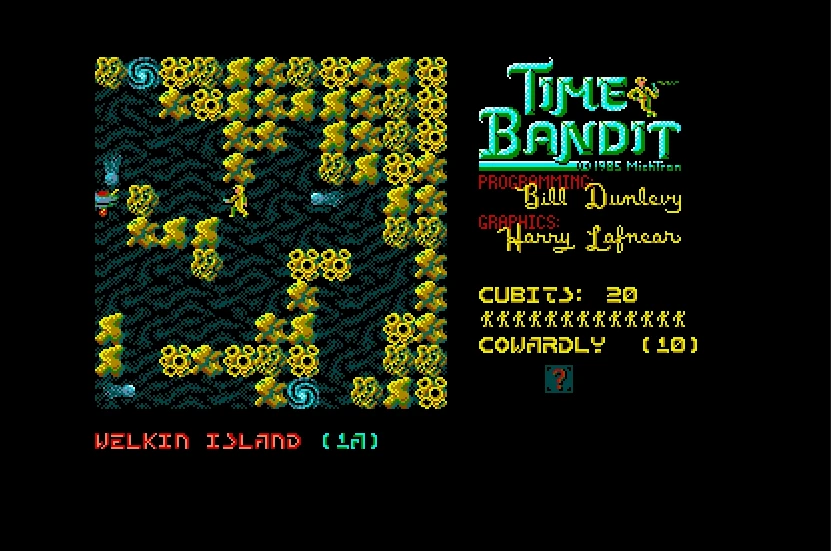
Welkin Island
Future Worlds
Click on images to zoom in.
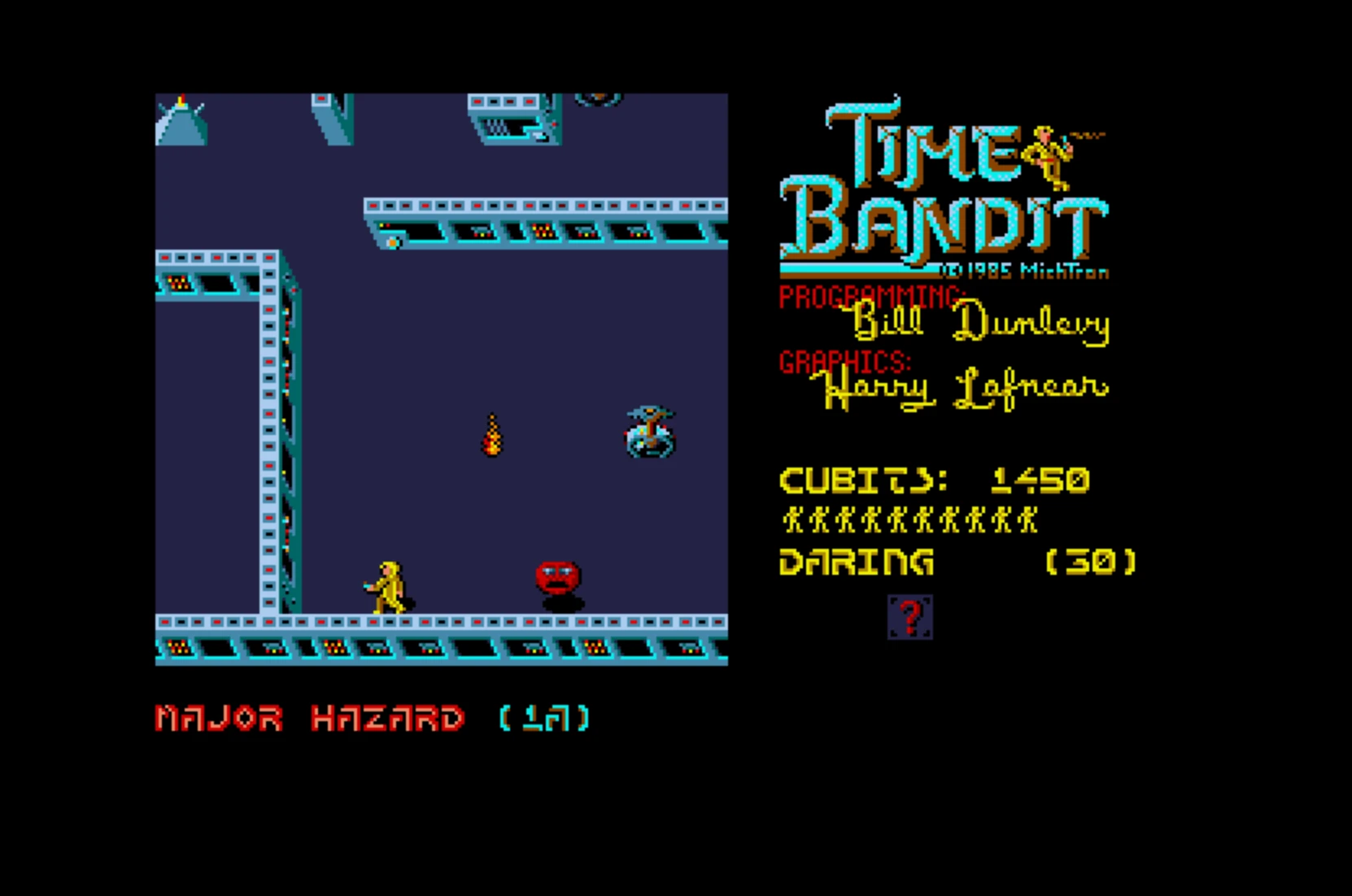
Major Hazard
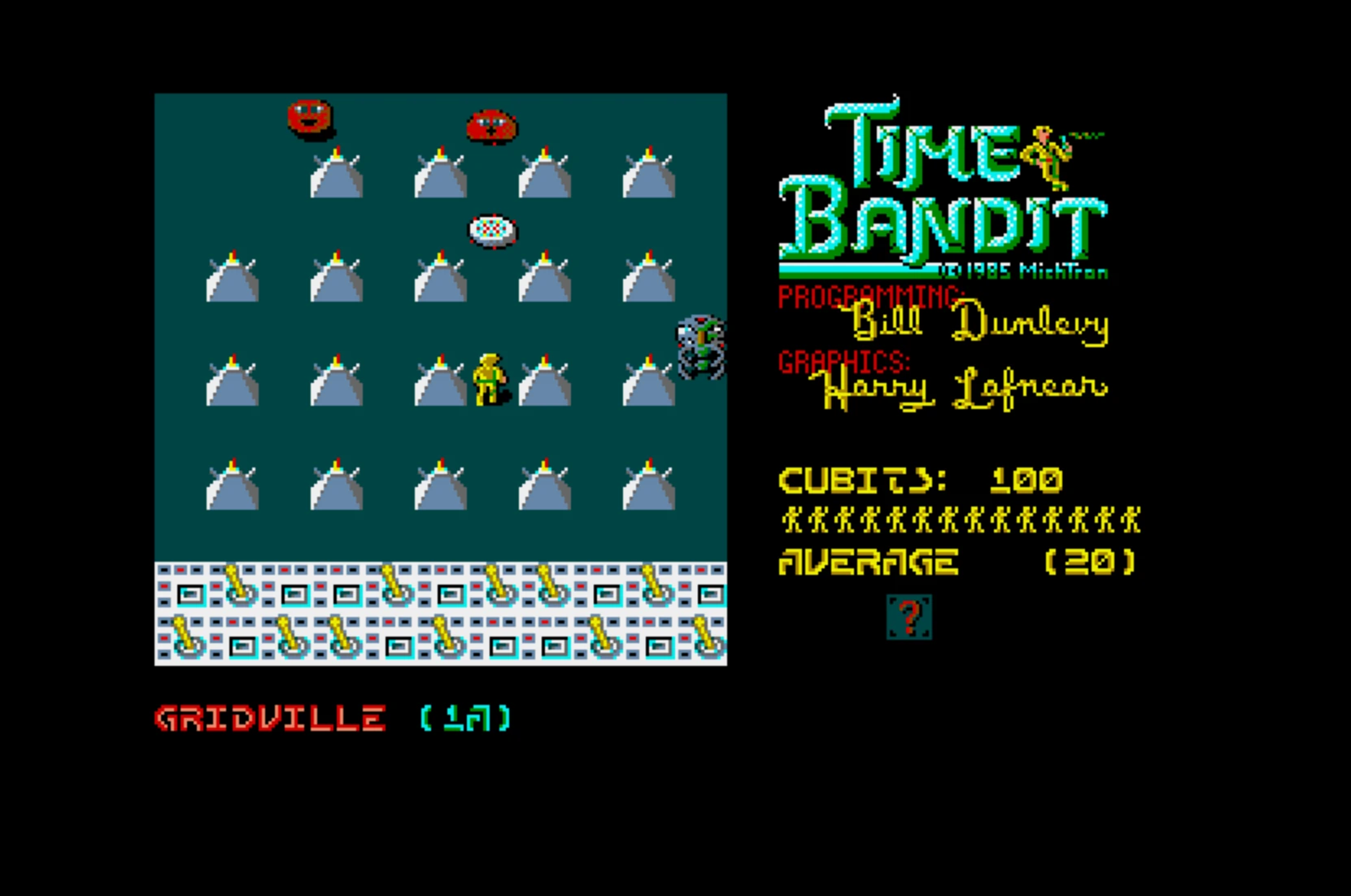
Gridville
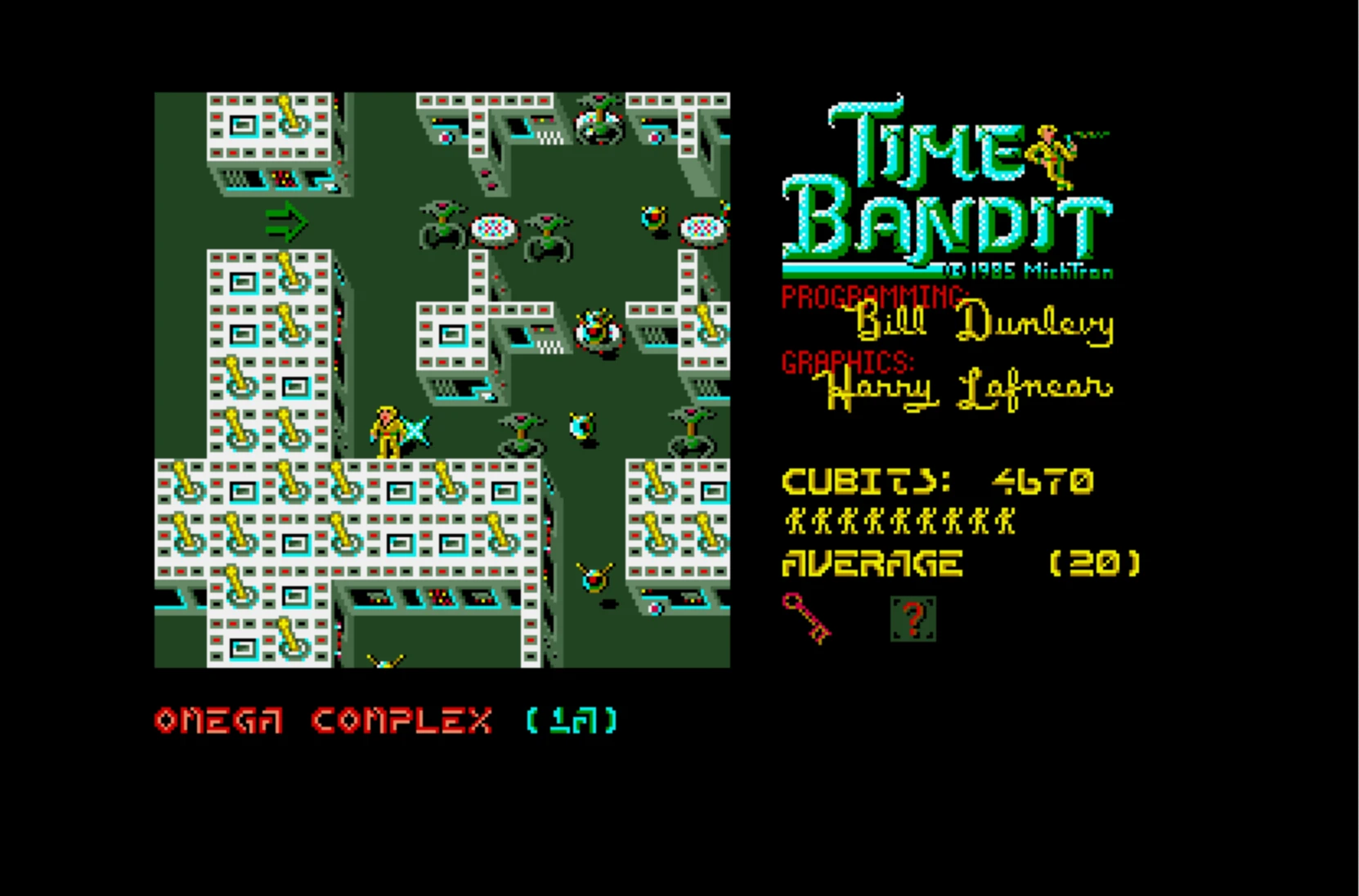
Omega Complex
Ancient Egypt Worlds
Click on images to zoom in.
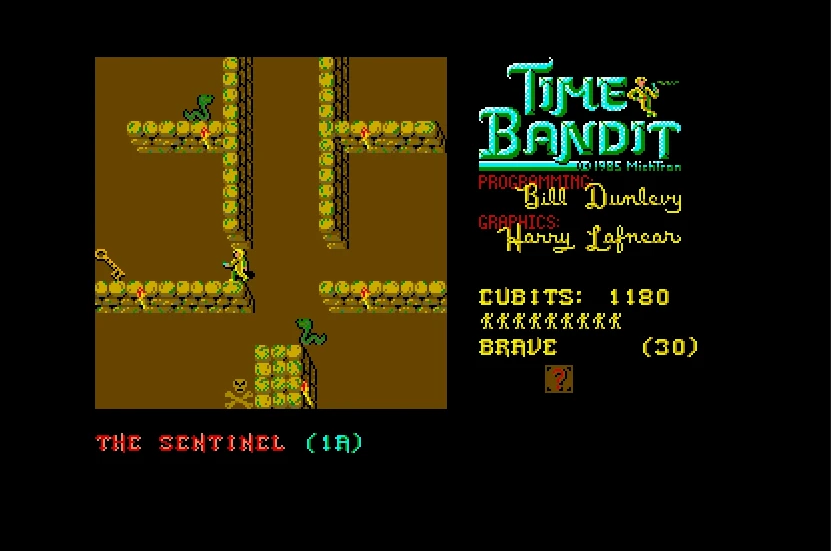
Sentinel
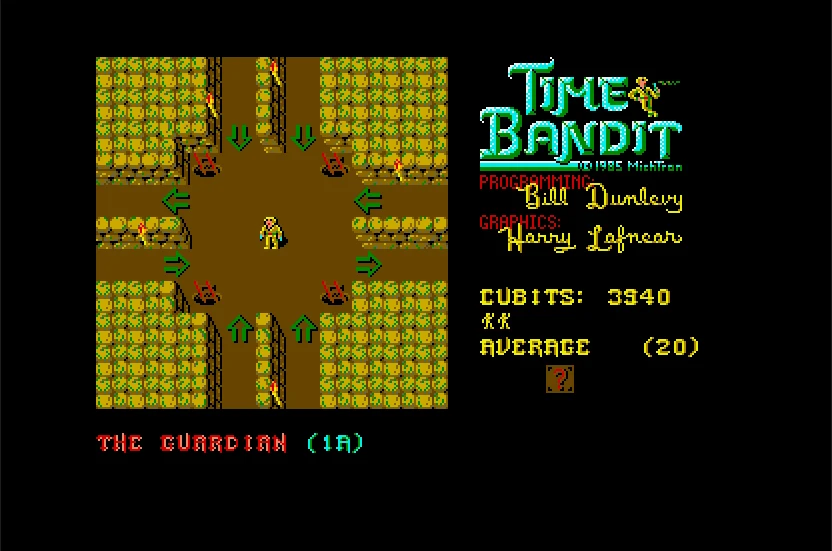
The Guardian
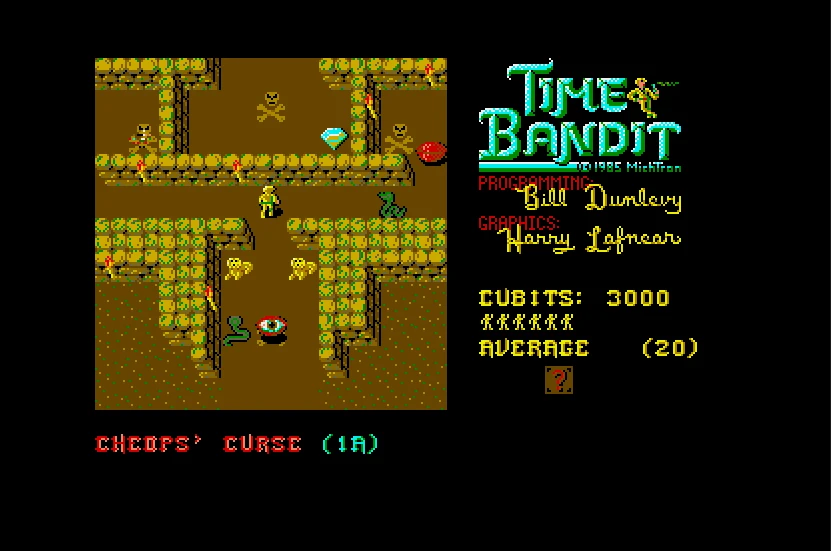
Cheops' Curse
Old West Worlds
Click on images to zoom in.
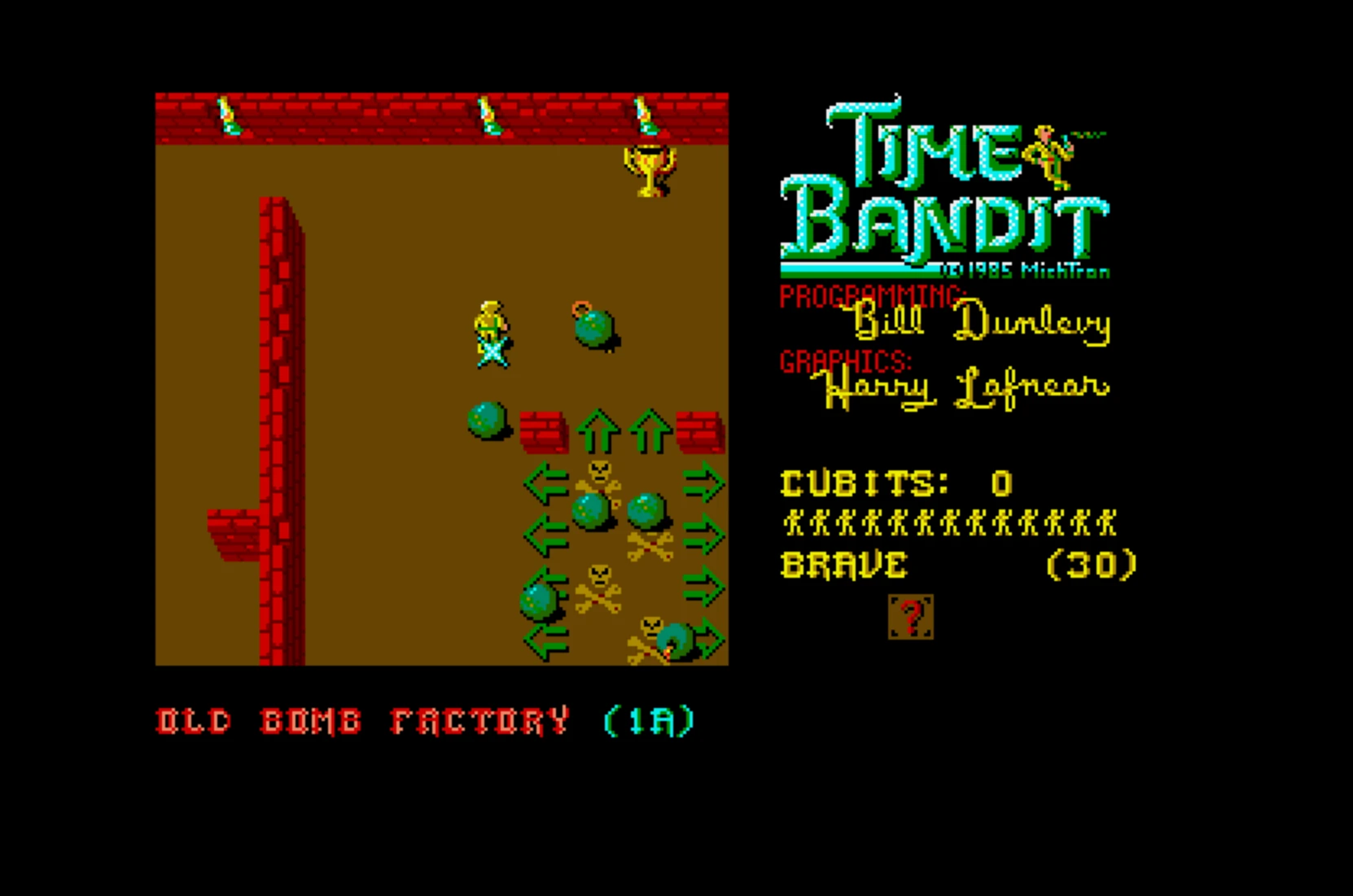
Old Bomb Factory
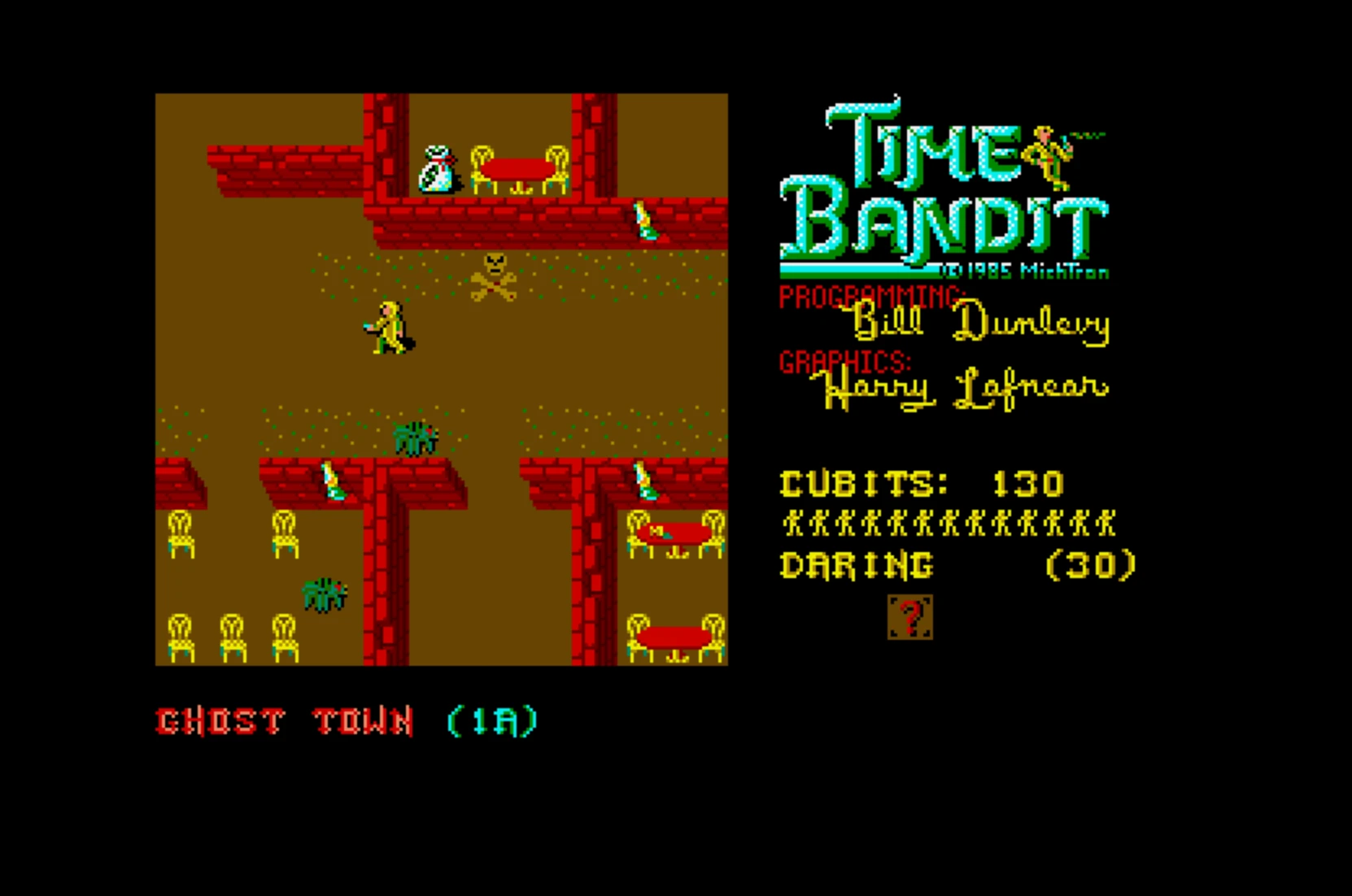
Ghost Town
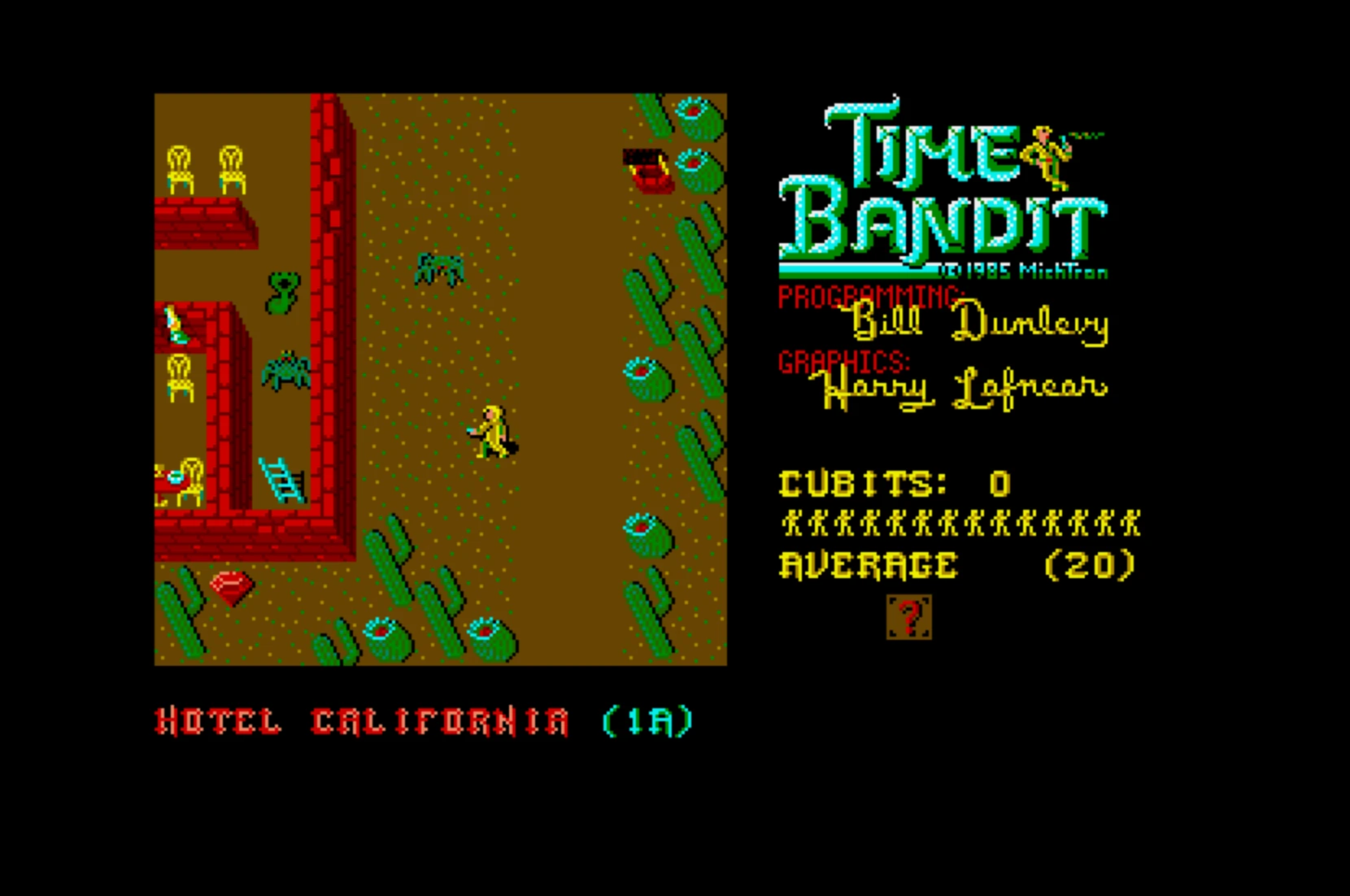
Hotel California
Fantasy Worlds
Click on images to zoom in.
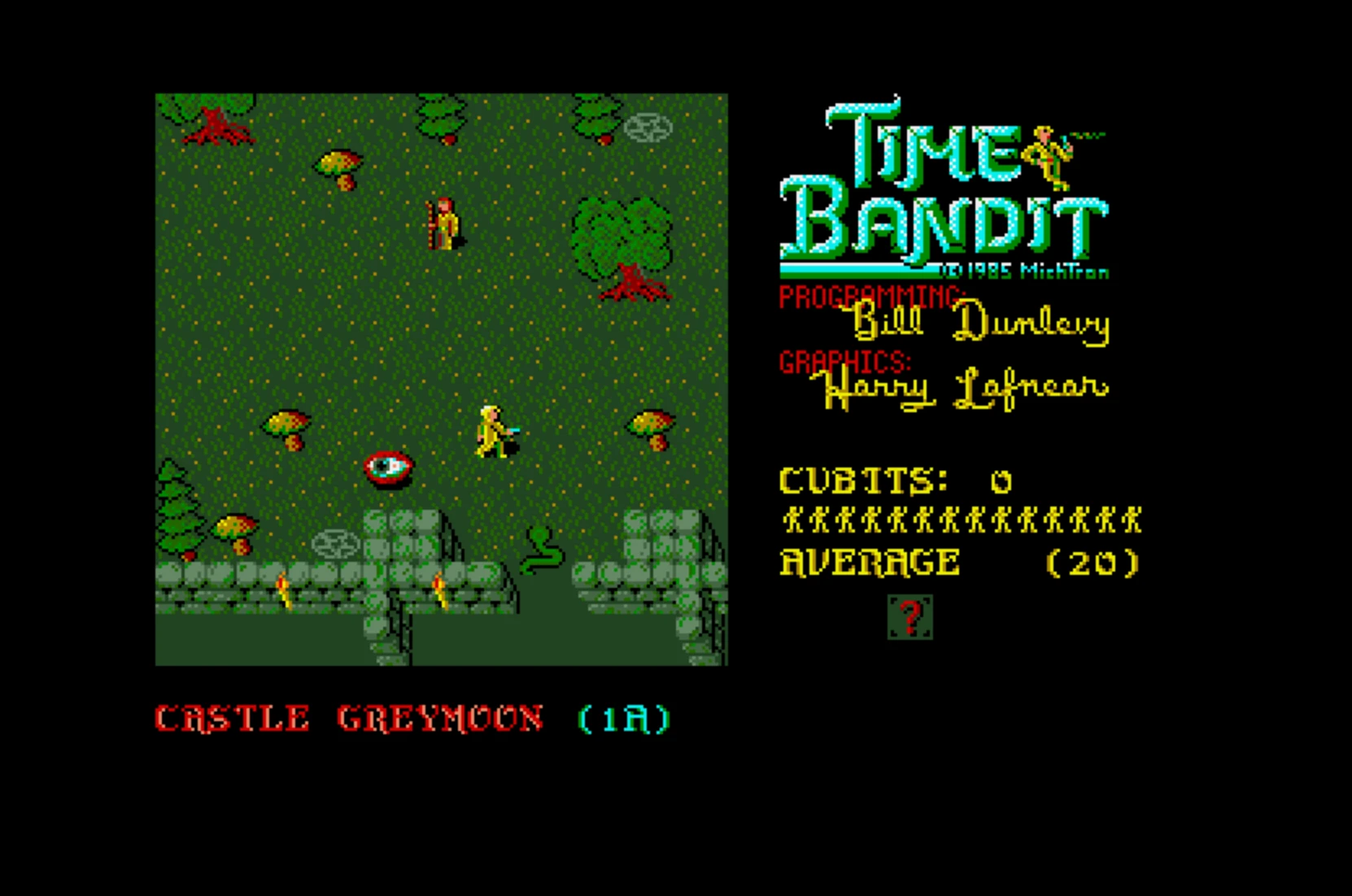
Greymoon Castle
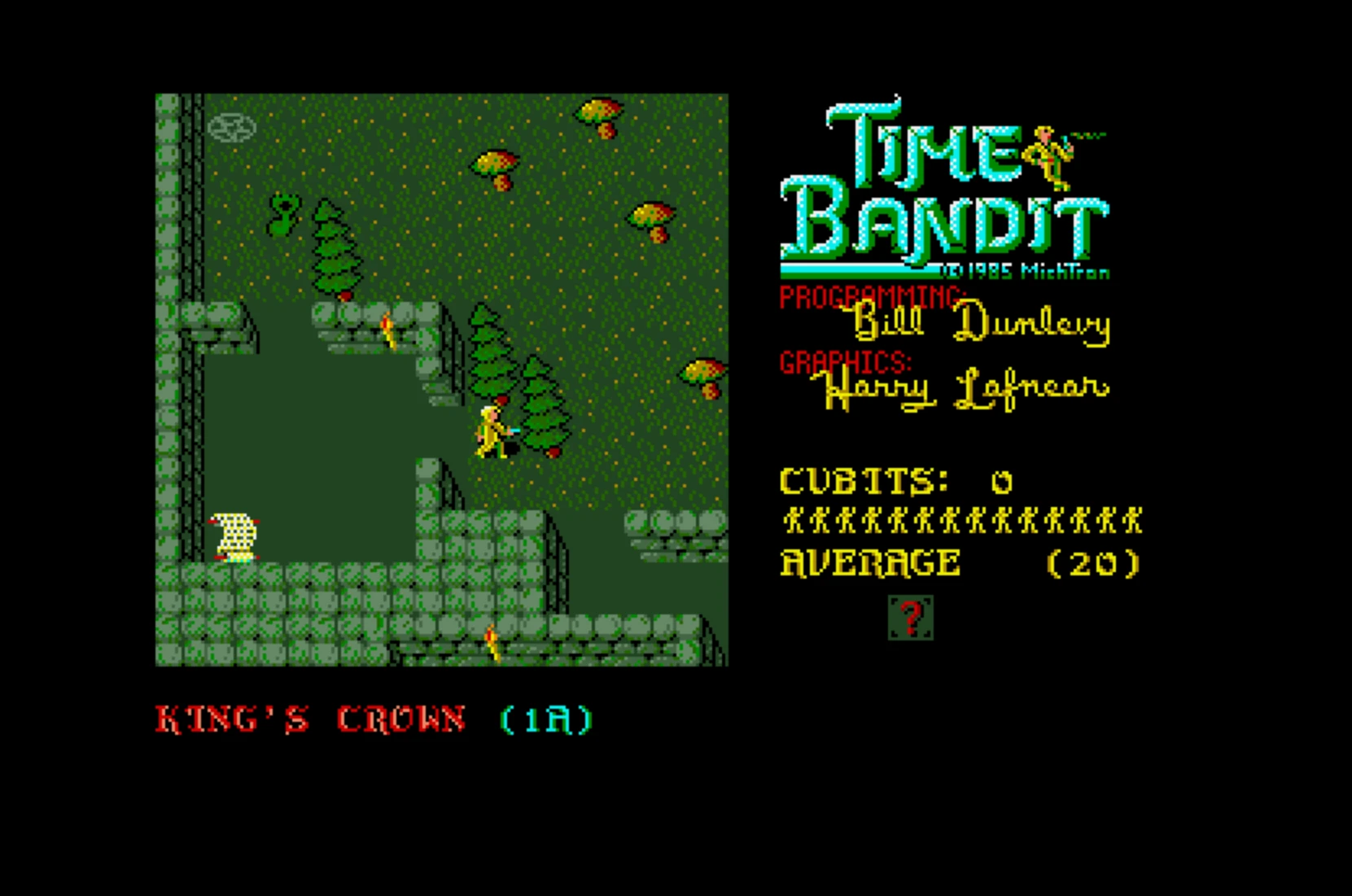
King's Crown
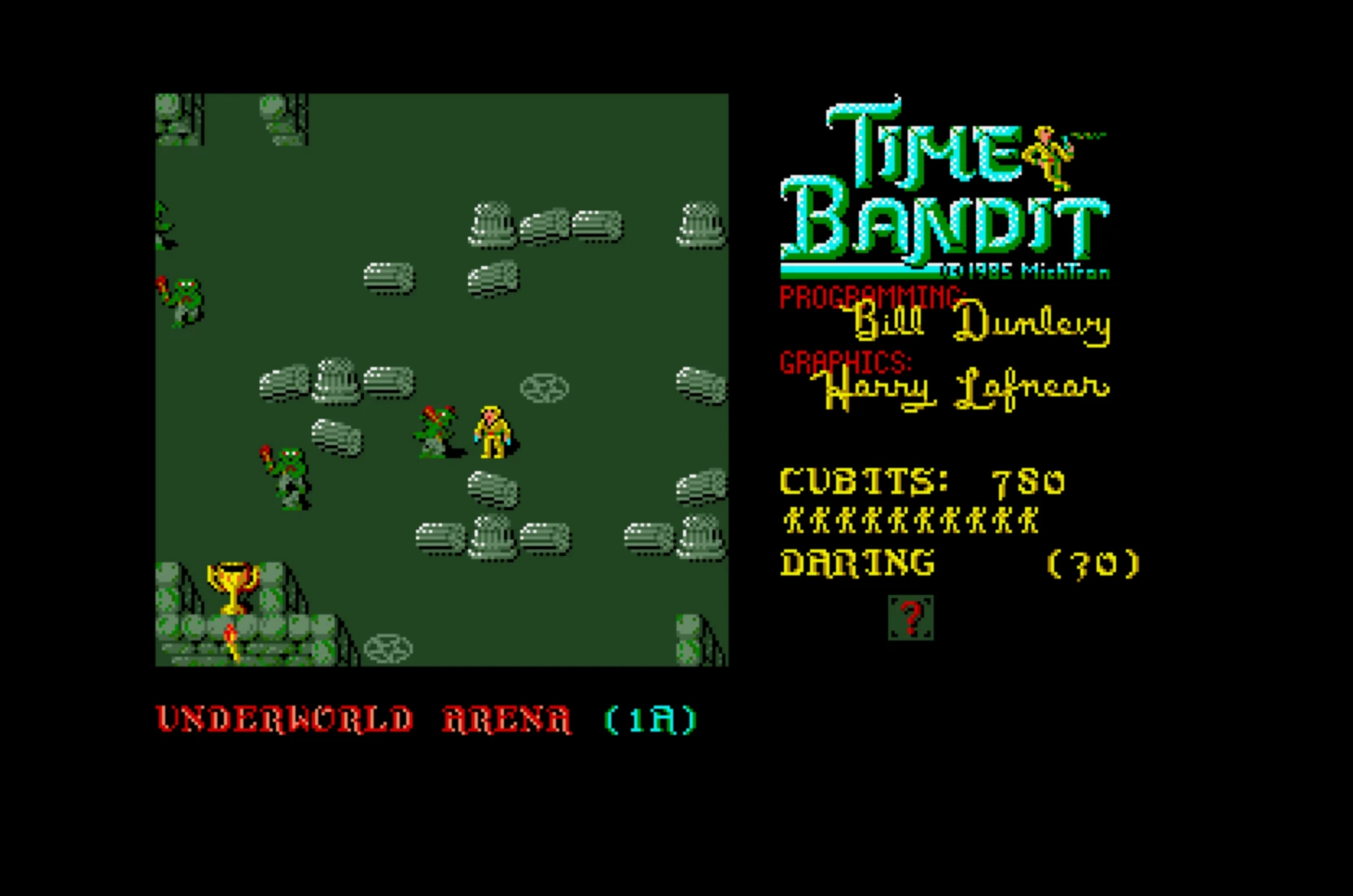
Underworld Arena
Arcade World
Click on image to zoom in.
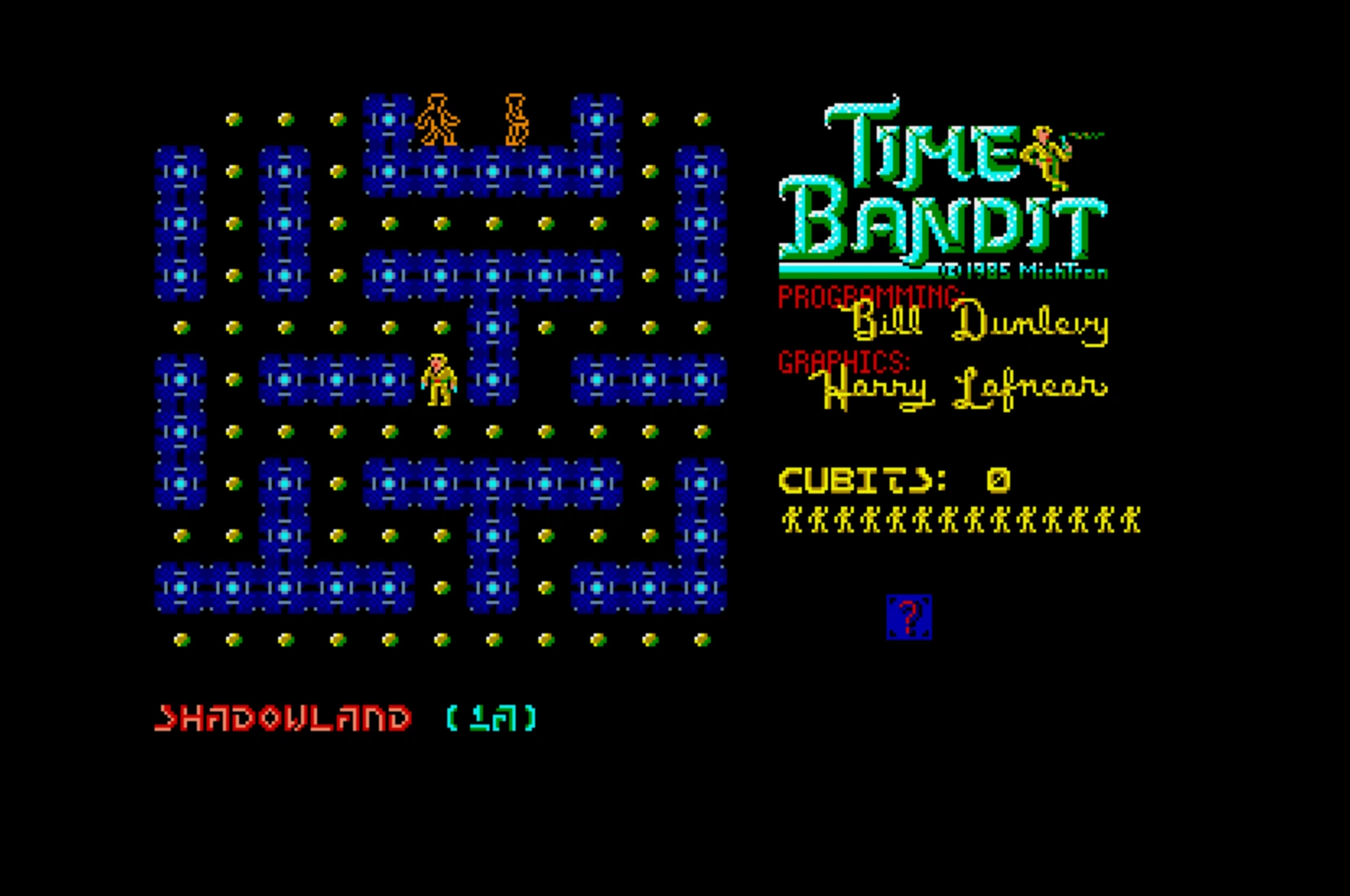
Shadowland (Pac Man clone)
Each world typically contains multiple levels, and the player must navigate through these levels by solving puzzles, collecting treasures, and defeating enemies. The game's structure encourages exploration and replayability, as players can travel between worlds and revisit levels to discover secrets and unlock new paths.
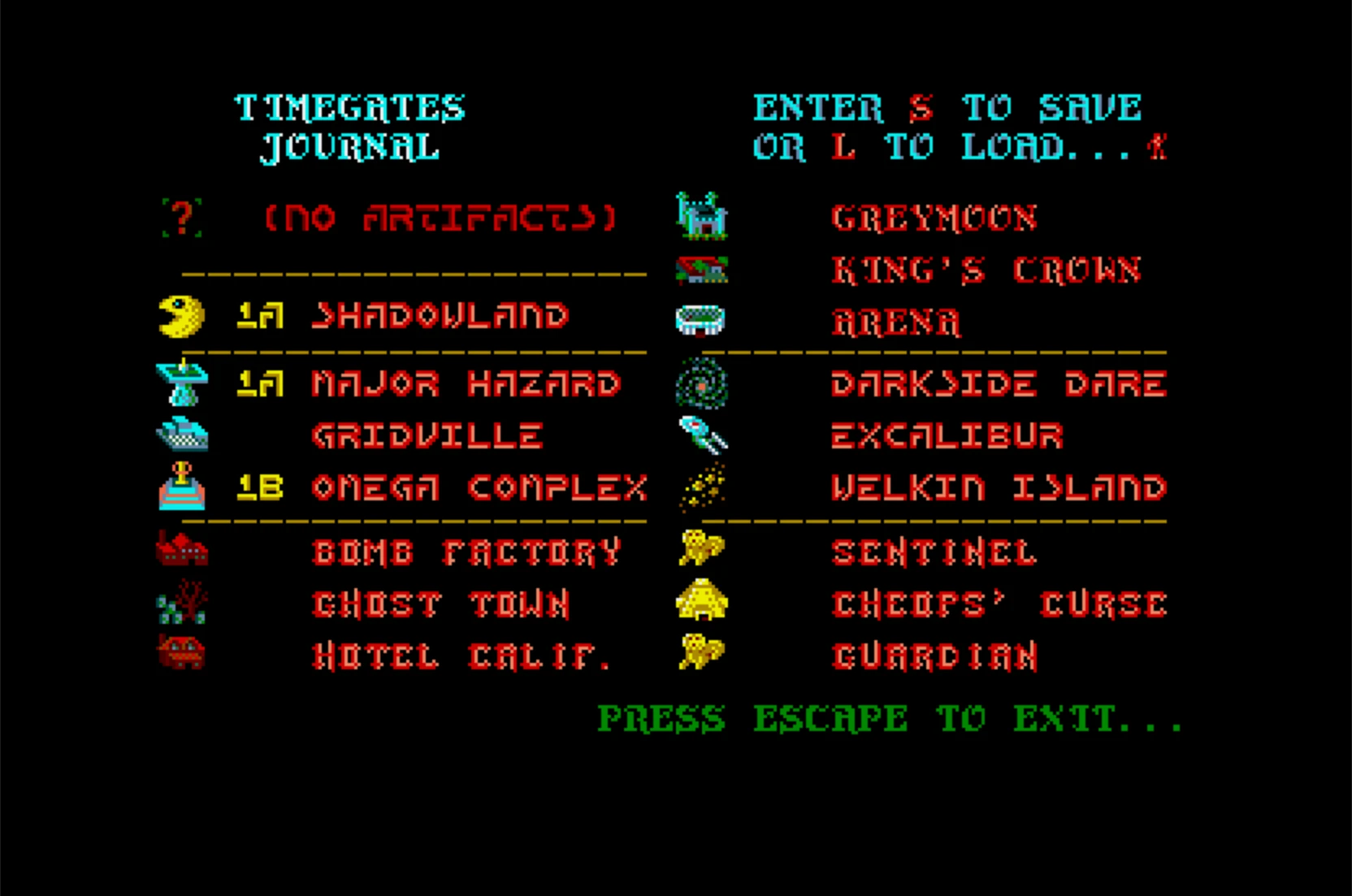
Players can check their progress in the dashboard at the time
gates.
The difficulty in each world and time zone increases progressively through four stages (1 to 4) with four levels (A to D) each. Here's how it works:
- First Stage (1A to 1D): On your initial visits, the time zone progresses from 1A to 1D. Each subsequent visit within this stage becomes slightly more challenging with more enemies and complex puzzles.
- Second Stage (2A to 2D): Returning to the same time zone for the second set of visits, the difficulty advances from 2A to 2D, with increased enemy aggression and puzzle difficulty.
- Third Stage (3A to 3D): The third set of visits progresses from 3A to 3D, further escalating the challenge with more numerous and tougher enemies, as well as more intricate puzzles.
- Fourth Stage (4A to 4D): The final set of visits takes you from 4A to 4D, presenting the highest level of difficulty with the most enemies and the most complex puzzles.
The only exception is the Excalibur. It jumps from 1A to 2B, 3C and on to 4D making gameplay much tougher at each jump.
Unique Two-Player Mode
By default, Time Bandit can be played by a single player. The game also offers a two-player cooperative mode, allowing friends to play together.
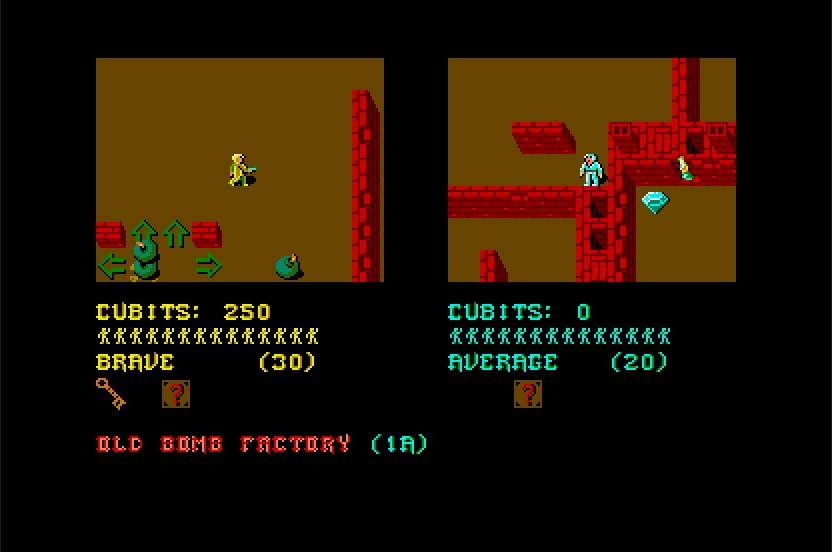
The screen is then split showing a view for each player. Both players access the same world, but then they have completely independent views of the current level. The best approach is to cooperate with each other but they can also shoot each other. The first player to be killed turns into a "shadow". They no longer get any points but they can still help the other player.
Text Adventure Components
Even though Time Bandit is an action game, some worlds have elements of text adventures. These components blend traditional action gameplay with interactive storytelling.
You might ask, what is a text adventure? Also known as interactive fiction, a text adventure is a type of game where players use text-based commands to interact with a story. You read descriptive text that sets the scene and provides details about the environment, characters, and plot. Then you type commands, such as "go north," "pick up key," or "talk to guard," to navigate the world, solve puzzles, and progress the narrative. The game responds to these commands with additional text, describing the outcomes of the player's actions and advancing the story based on their choices.
Click on images to zoom in.
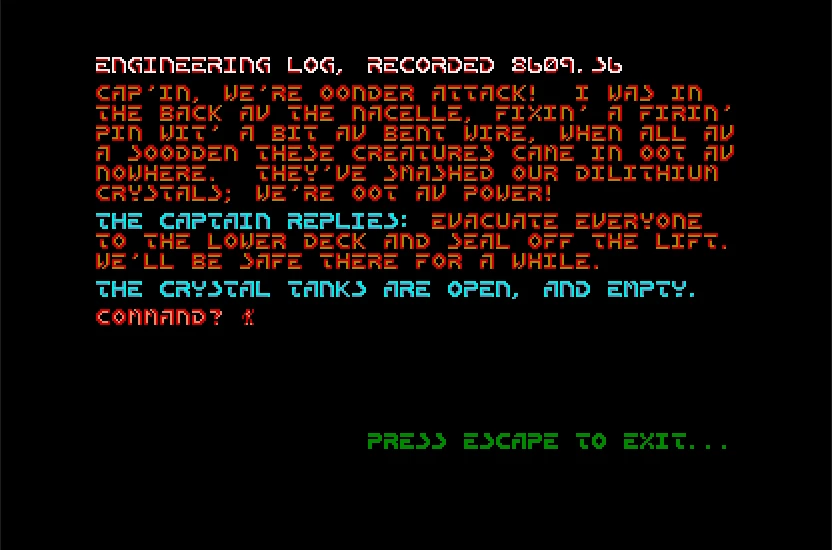
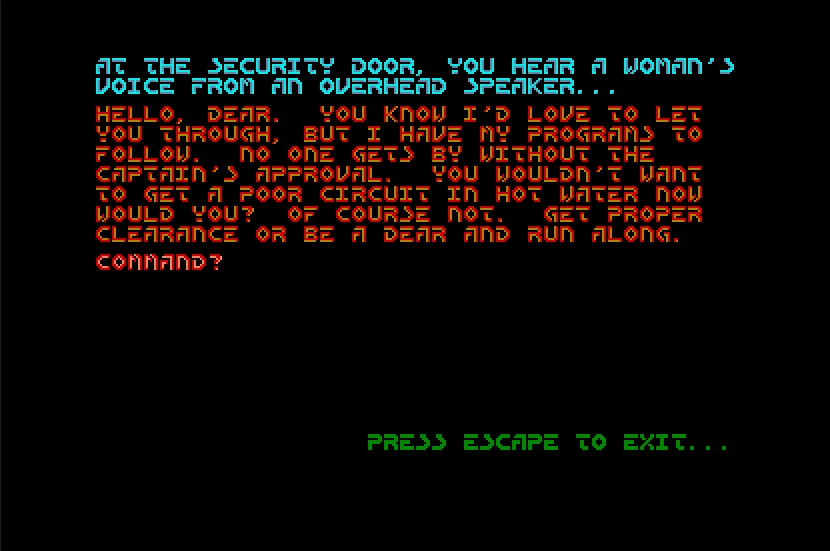
It was totally crazy that an arcade-like action game would make the player interact with the game in some of its worlds purely by reading and writing. On the Excalibur world, a player bumps into a console and is presented with a description that something is amiss in the ship. For the first few levels, you really do need to bother with this. It only becomes relevant in the higher levels. Other text adventure components can be found in Castle Greymoon. You run into a non-player character, a hunter, the screen turns black and only shows a text description of the character. You are prompted to enter commands to interact with the hunter. And there are many others too.
These segments present narrative elements, puzzles, or decision points in text form, requiring players to read and choose responses or actions. The further you get in the game, the more the text adventure sections are woven into the overarching plot, providing context and depth to your journey. These narratives provide a backstory, character insights, and lore about the game's universe.
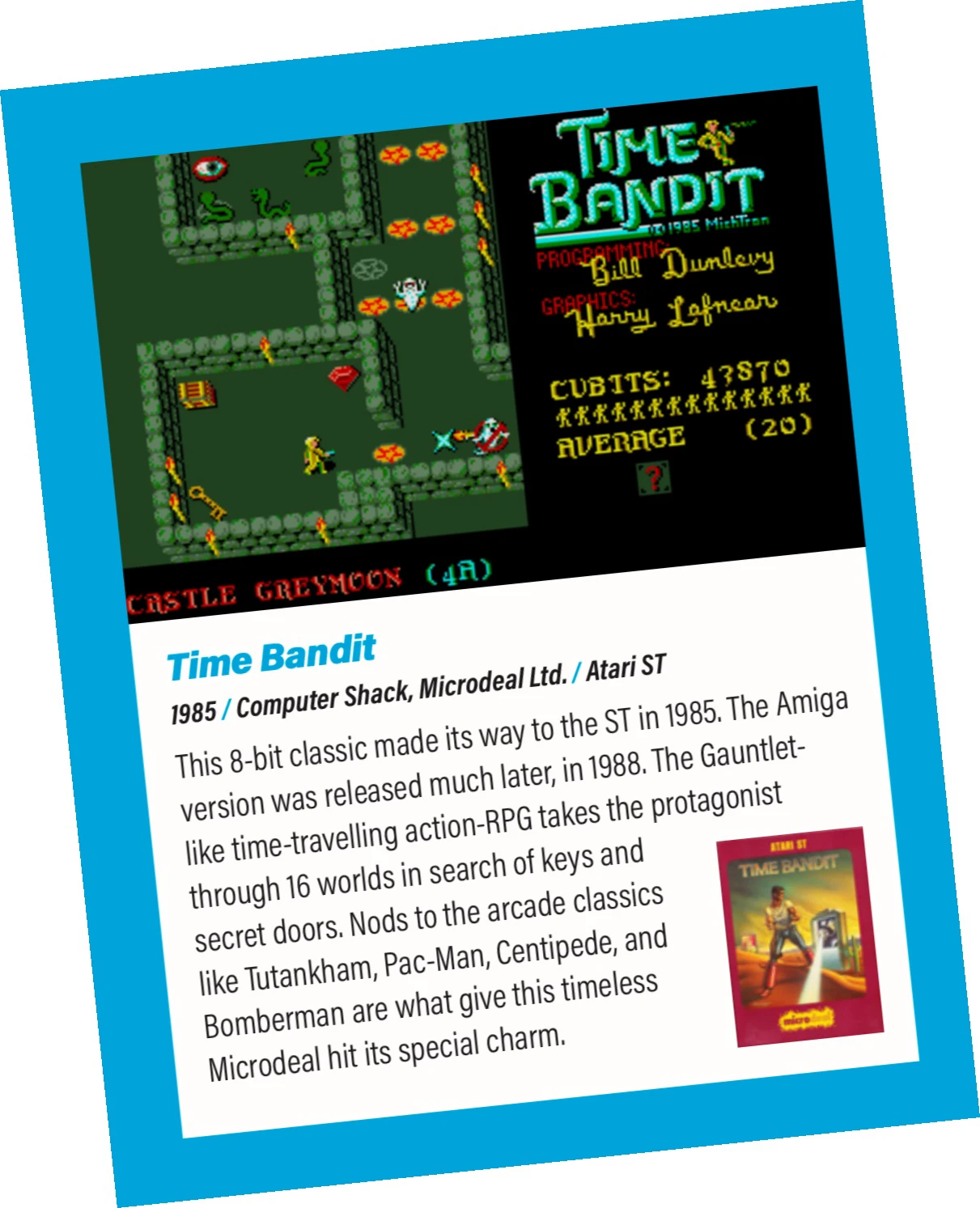
A review of the game in the
Microzeit book 'Tha Flame Wars: ST-Amiga
A Brief History of the Game
Time Bandit was created by Bill Dunlevy and Harry Lafnear. The former was the programmer, the later was the graphics and game designer In an interview with Atari Legend, Harry Lafnear described the process of creating Time Bandit.
Originally, Lafnear developed first versions of the game for the Tandy TRS-80 Model I and the TRS-80 Color Computer, a machine popular in the US at the time. He was only eighteen years old at the time and was inspired by the Konami arcade game Tutankham (see a video of the arcade game here) and classic text adventures. Lafnear aimed to combine fast-paced action with immersive storytelling.
Screenshots of the TRS-80 Model I Version
Click on images to zoom in.
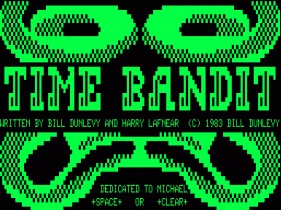
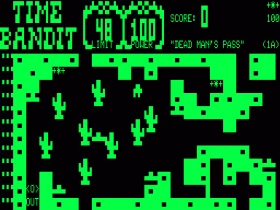
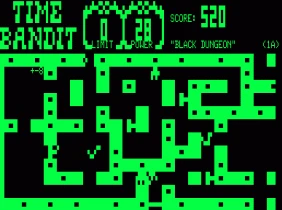
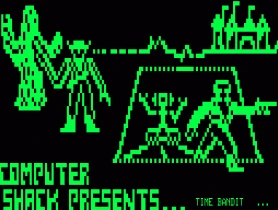
Source: Bytecellar
He said in the interview at Atari Legend: "Wow, does that mean I'm old? You know, I was just 18 when I started work on the first version of Time Bandit. So in a way, I've been playing it since I was a kid too."
He later ported it to the very rare Sanyo MBC-550. This version was very obscure and featured unique graphics. Years later, Bytecellar found the game for this system and presented screenshots to the world.
The best port was the one to the Atari ST, where it gained more attention. The enhanced graphics and processing power of the Atari ST allowed for a richer gaming experience. Lafnear focused on creating a game that blended different genres. He wanted to offer players a mix of action-packed gameplay and intricate text-based puzzles, providing a unique and engaging experience.
Despite the interesting blend of gameplay and ideas, Lafnear does not think that he created a new genre. This is what he said in the Atari Legend interview: "As for creating a genre, I'd love to take credit for that, but Time Bandit was really just another in a long line of maze shoot-em-ups. I think Bill and I did a really good job and made the game stand apart."
Time Bandit became a cult classic, remembered for its unique blend of genres and engaging gameplay. Lafnear estimates that the game sold 75,000 copies when it was originally released. He wanted to write a sequel but never got round to it. Though, the game was popular enough that he wrote a guidebook called "The Timelord's Handbook".
Screenshots of the Version for the TRS-80 Color Computer (CoCo)
Click on images to zoom in.
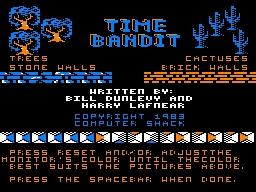
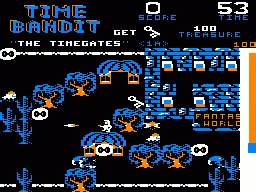
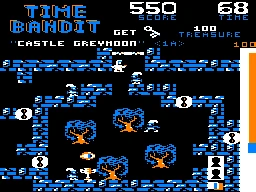
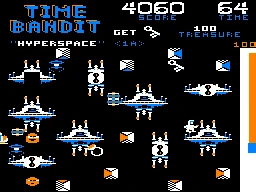
Source: Bytecellar
There are quite a few easter eggs in the game that take inspiration from the popular culture of the 1970s and 80s.Here are some of them as described by Lafnear in the interview.
- The King's Crown world mentions the spirits of Zardoz in one of the text adventure components. This is a reference to the frankly ridiculous fantasy movie directed by John Boorman, famous for Sean Connery wearing a red thong-suspender combination.
- In the graveyard world when the player shoots a ghost, it momentarily turns into the Ghostbusters symbol.
- The spinning blades were based on the Glaive, the weapon in the movie 1980s fantasy movie Krull.
And there were many others. I strongly recommend reading the full interview with Lafnear on Atari Legend.
Other Versions of the Game
An early version of the game was originally released in 1983 for the TRS-80 Color Computer in 1983. The game was later ported to the odd PC-compatible Sanyo MBC-55x with an 8-color display. After the success of the Atari ST version, Time Bandit was ported to the Commodore Amiga, and MS-DOS platforms.
Screenshots of the Sanyo Version
Click on images to zoom in.
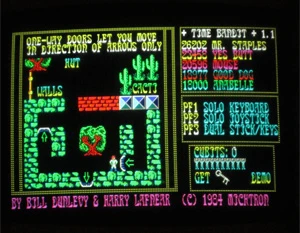
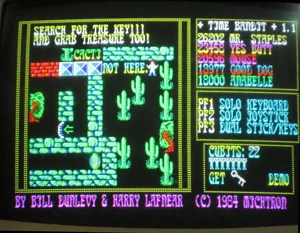
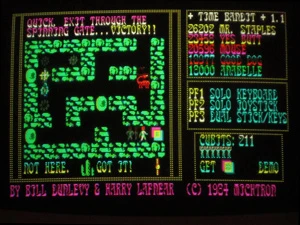
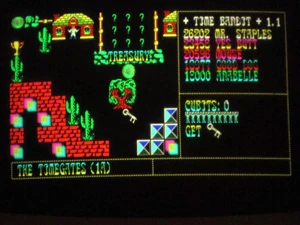
Source: Bytecellar
Supplementary material
There are numerous resources available for Time Bandit fans, including a comprehensive guidebook, a full walkthrough, and a level editor.
The Timelord's Handbook
After the game's release, Harry Lafnear wrote a comprehensive guide to Time Bandit which serves both as a detailed manual, hint book and backtroung lore for the game. It is called "The Timelord's Handbook". The book is divided into five distinct sections.
The book starts out as a game manual which provides an updated and illustrated guide to playing Time Bandit, covering the essentials needed to navigate and enjoy the game.
The clues section offers detailed information about the legends of each land within the game, along with clues, maps, and playing tips to help players advance.
In the fiction section, Lafnear provides the lore of the Timelords, exploring their history and the intricacies of their advanced technology.
The perspectives segment discusses the development of the game, offering insights into its creation and pondering whether anyone has ever reached the game's ultimate conclusion.
The answers section provides solutions for challenging parts of the game, including puzzles related to Excalibur and Ghost Town, along with secrets to achieving invulnerability and discovering hidden bonuses.
Unfortunately, the book is not available in any of the official sources. You might get lucky on eBay. It is certainly still copyrighted, so any electronic copies distributed without the rights holders' permission are illegal. If one were so inclined then, one could look on the web and perhaps find a PDF version. If one were so inclined...
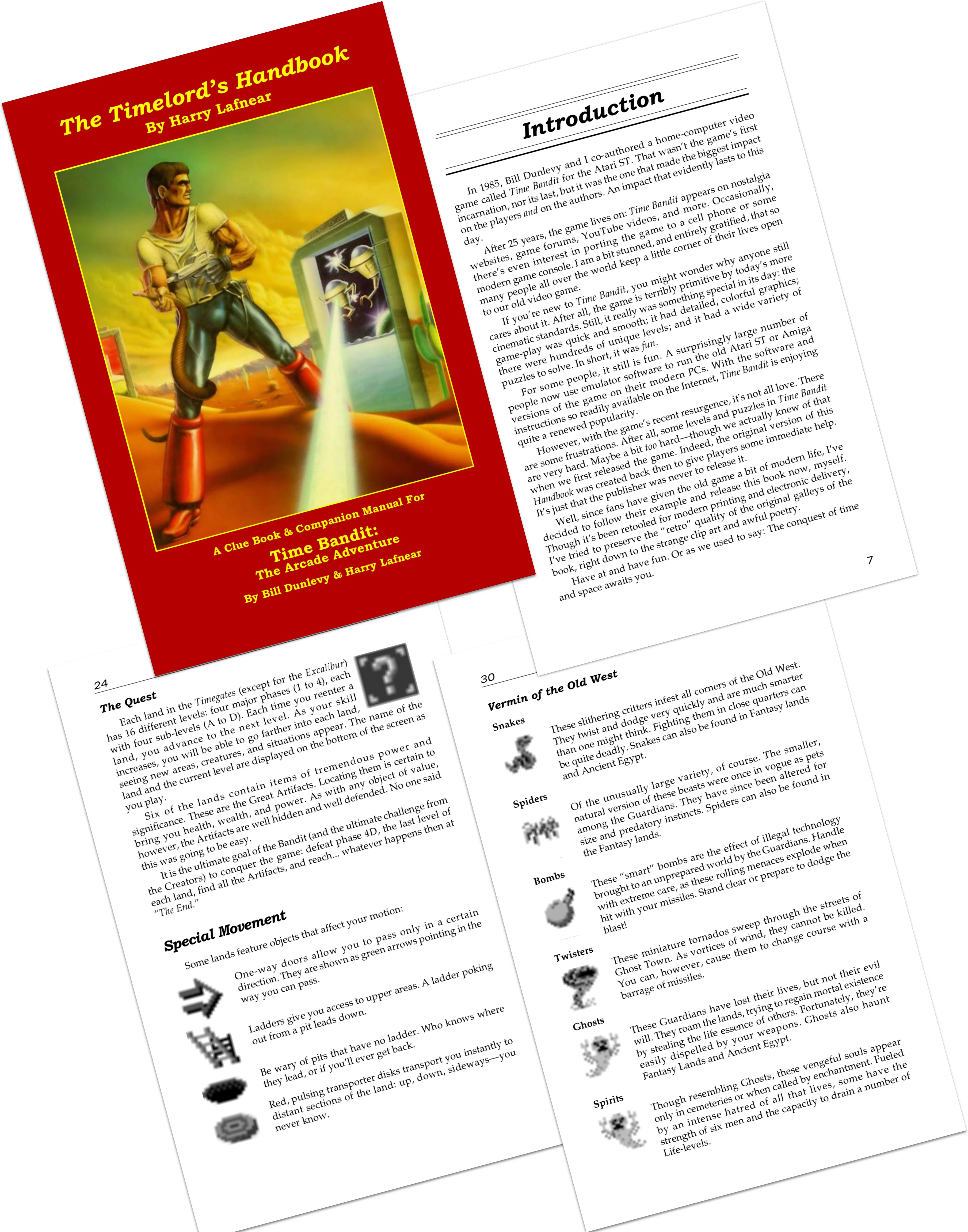
"The Timelord's Handbook" by Harry Lafnear
Solution to Winning Time Bandit
IGN provides a full-walkthrough solution to the Time Bandit. It is a text file that describes how to solve the game. It is a bit of a spoiler, so only read it if you are really stuck.
Kroah's Level Editor
There is a level editor for Time Bandit called Kroah's Time Bandit Level Editor. It allows you to create your own levels for the game. The editor is available for Windows, MacOS, and Linux. You can download it from the website and start creating your own worlds for Time Bandit.
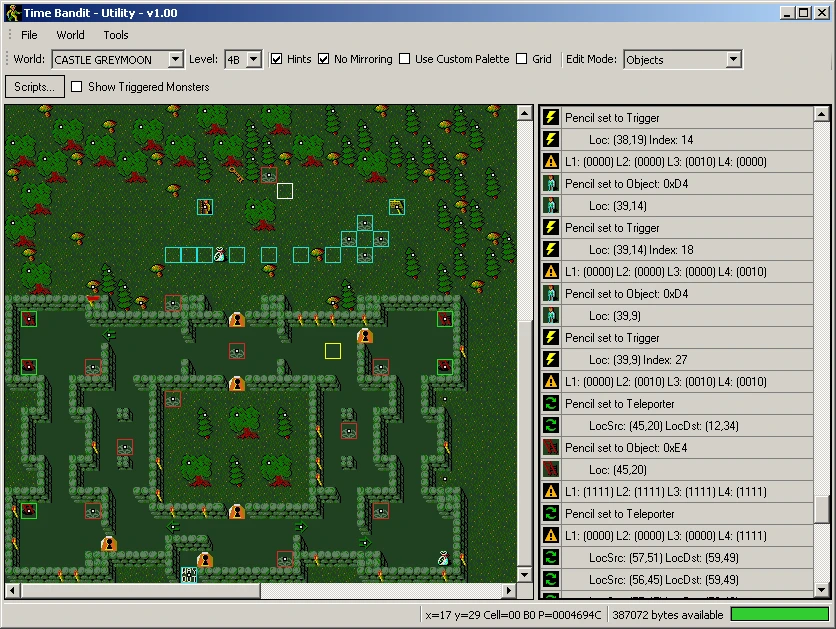
Other Resources
- Time Bandit on Atarimania
- Time Bandit on Abandonware
- Time Bandit on Amiga Reviews
- Bytecellar's Time Bandit article
- Another article about the game on Bytecellar
- Youtube Playlist with a Complete Walkthrough of all Worlds
Legal Options to Play the Game
Like many games from the 1980s, the legal situation nowadays with disk images captured in the past decades is unclear. There are a number of legal and probably not quite legal ways to get a copy of Time Bandit.
Buy It on Steam
One of the easiest ways to get a legal copy of Time Bandit is to buy it on Steam. The game is available for Windows, MacOS, and Linux. The Steam version looks like it is a port of the MS-DOS version. It is a faithful enough recreation of the original game. The game is available for $4.99 (August 2024).
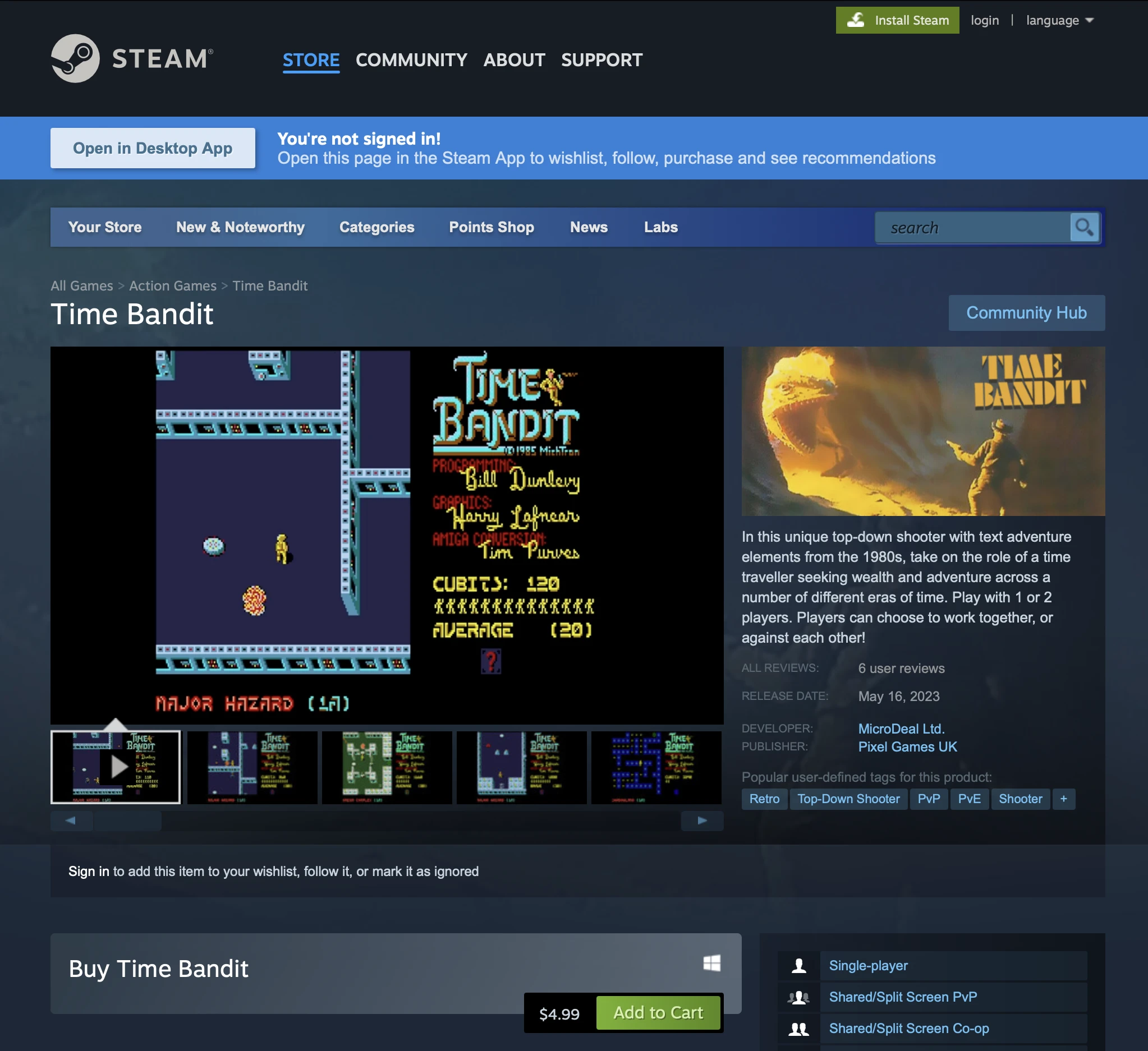
Purchase a Used Copy
The most obvious way to get a legal copy of Time Bandit is to buy a used copy on eBay or other auction sites to run it on an original Atari ST or Amiga. Boxed copies are still available that include the beautiful cover, the manual and a disk with the game. In most cases, you unfortunately don't know which version of Time Bandit is in the box (2.0 or 2.1).
In addition, the original disks are decades old by now and might have degraded. Having an original copy of the game probably entitles you to legally using it in a downloaded disk image or ROM file as outlined below.
Download from Atarimania
Quite a few sites offer disk images and ROMs of Time Bandit for download, e.g. Atarimania. This does not mean that this is a legal, even though the sites suggest that Time Bandit can be regarded as abandonware. If you own an original physical version of the game then the argument could be made that you can download the ST disk image and use it. To be fair, it is a bit unlikely that anyone will actually have an issue if you use the disk image.
You can find a disk image of the latest ST-Version on Atarimania.
You can run it in an emulator like Hatari (MacOS, Linux, Windows) or Steem (Windows).
You can also run it on a real Atari ST by transferring the disk image to a physical 3.5" disk using Peter Putnik's Floppy Image program or the MSA Converter. You can also run the disk images directly on the Atari ST using floppy disk emulators like Gotek, HxC or CosmosEx. You can also run it on a MiST or a MiSTer FPGA retro machine.
Play the MS-DOS Version Online
You can play the MS-DOS version of Time Bandit in the web browser here: https://classicreload.com/time-bandit.html
The emulator uses a web version of DOSBox emulator. When you launch the game, you are asked to choose in which graphics mode you want to run it:
- CGA
- Tandy
- EGA
- VGA
VGA graphics are closest to the Atari ST and Amiga versions (even though VGA can be far better looking in capable hands). The EGA version is surprisingly close to the Atari ST original with only few color differences. I'd have loved to see the Tandy version in action but for some reason, it does not work in the web emulator.
Your mileage may vary but running Time Bandit in the browser is not a great experience. If you use the keyboard controls, then some browsers will instead override the game's controls because they use the arrow keys for scrolling around the page and the space bar to move down the page.
Play the Amiga Version on TheA500mini
In early 2024, RetroGames Ltd. released a modern recreation of the Commodore Amiga 500 in a tiny enclosure called theA500mini. This is a console style machine that you simply connect to a modern TV or monitor and start using immediately. It comes preloaded with 25 Amiga games but can also be expanded to run the full Amiga desktop experience and any games or applications suitable for the A500 with the original Chipset to the powerful A4000 with the Advanced Graphics chipset. By all accounts, the games are officially licensed and run perfectly using the accompanying gamepad and mouse. You can read about my experience with theA500mini in a pub.
RetroGames Ltd. has released a number of firmware updates, the last one of which adds a new game to the device: Time Bandit. Once you've updated the firmware, Time Bandit appears in the list of games. You select it and you are off the races with a brilliant version of the game running reliably and legally. You also benefit from the amenities theA500mini provides, e.g. save states and resolution upscaling.
Click on images to zoom in.
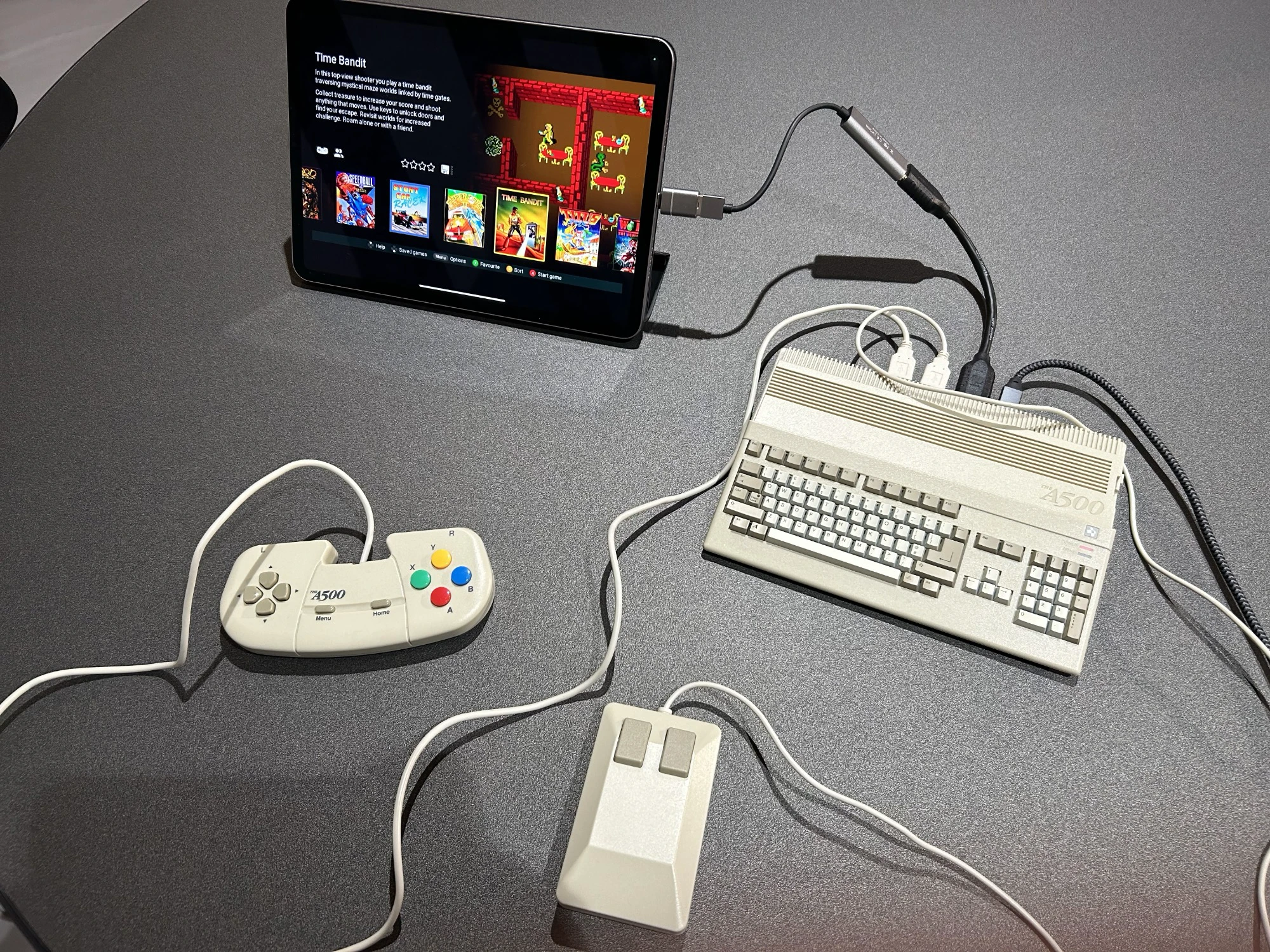
TheA500mini's selection screen with Time Bandit
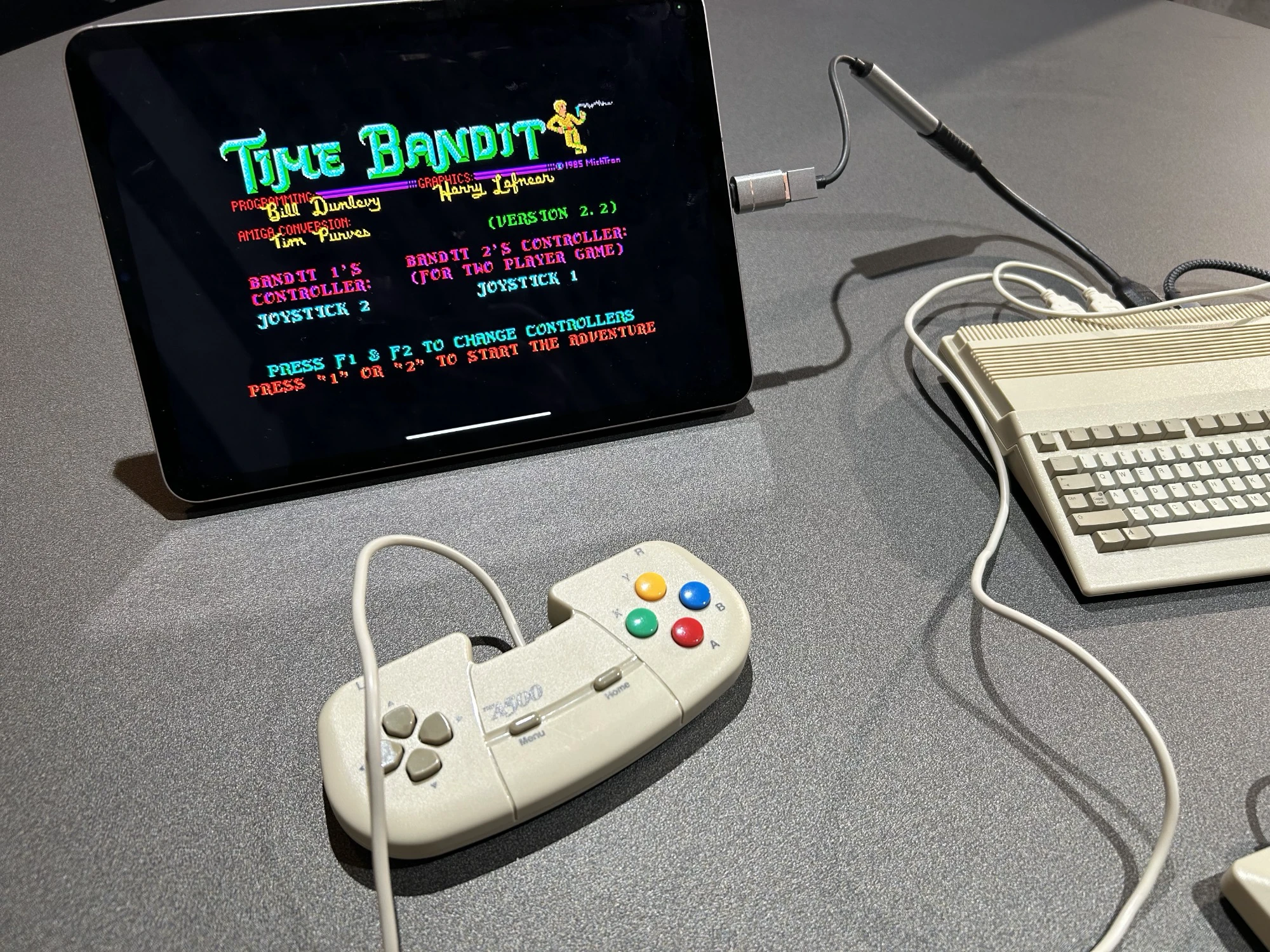
TheA500mini showing the title screen of Time Bandit
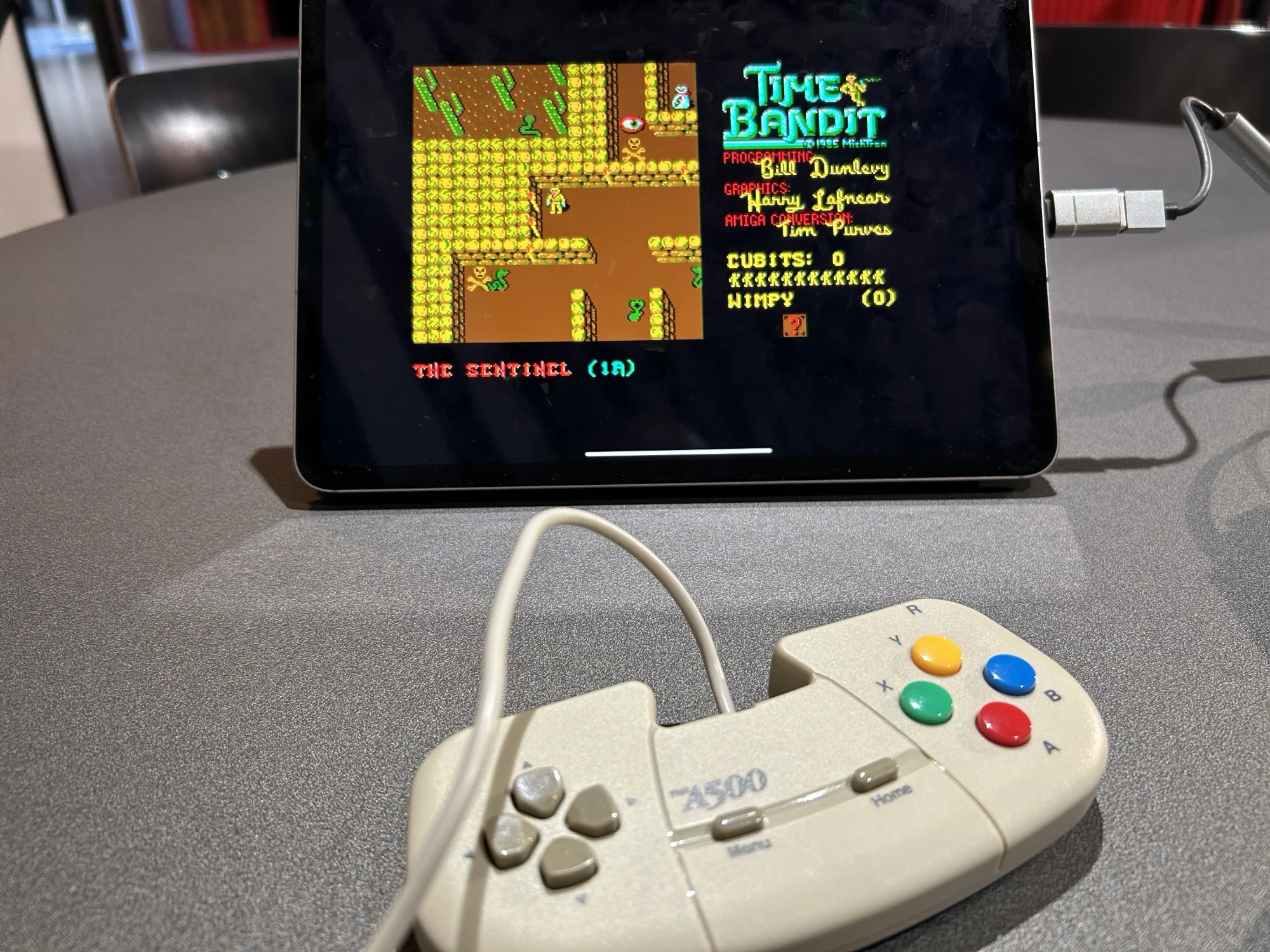
All out action playing Time Bandit on TheA500mini
The Wonderful Time Bandit: Exploring 16-bit Worlds!
At the time of its release, Time Bandit was well-received for its engaging gameplay, innovative use of time travel, and the great variety of worlds and challenges. To this day, it remains a fondly remembered title among retro gaming enthusiasts and is considered a classic of the 1980s gaming era.
I can unequivocally state that I adore Time Bandit. However, I am not blind to its shortcomings. It was an early game for the ST and did not yet benefit from all the discoveries and tricks to eke out more colors or smoother scrolling from the machine's hardware. When the platform matured, much more lavish games were released (though, very few of them had worlds as expansive and gameplay as immersive). Another drawback of Time Bandit is its rather pedestrian soundscape. It has no music, and the sound effects are utilitarian. That being said, between the two developers (one a programmer on a new platform, the other a game designer and graphics artist), it would have been a bit too much to ask that among their many talents they should also count music composition.
Time Bandit stands out for its creativity and the way it combines different genres into a cohesive and enjoyable gaming experience.
PS: The game is not related to Time Bandits, the Terry Gilliam movie from 1981, or the Time Bandits series from 2024 on Apple TV+.